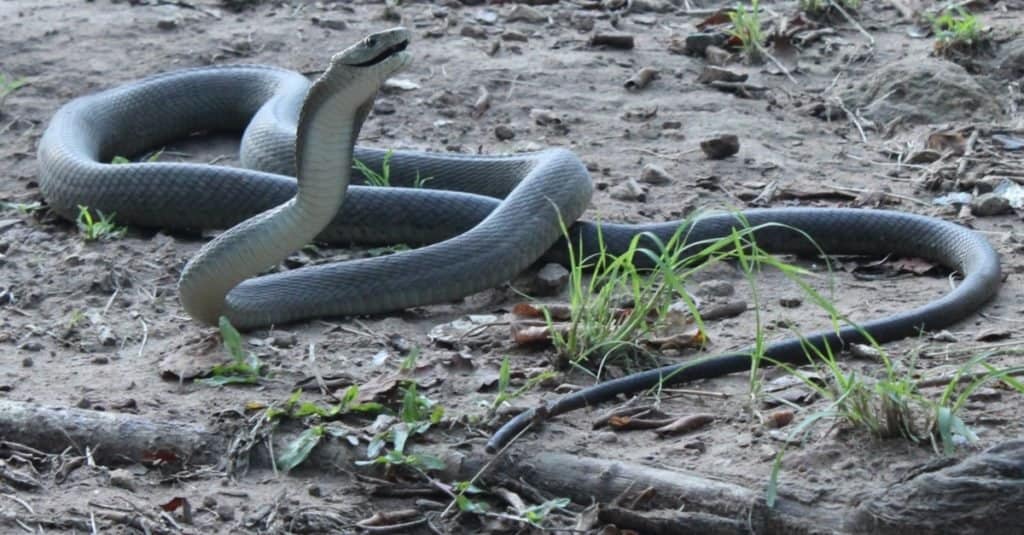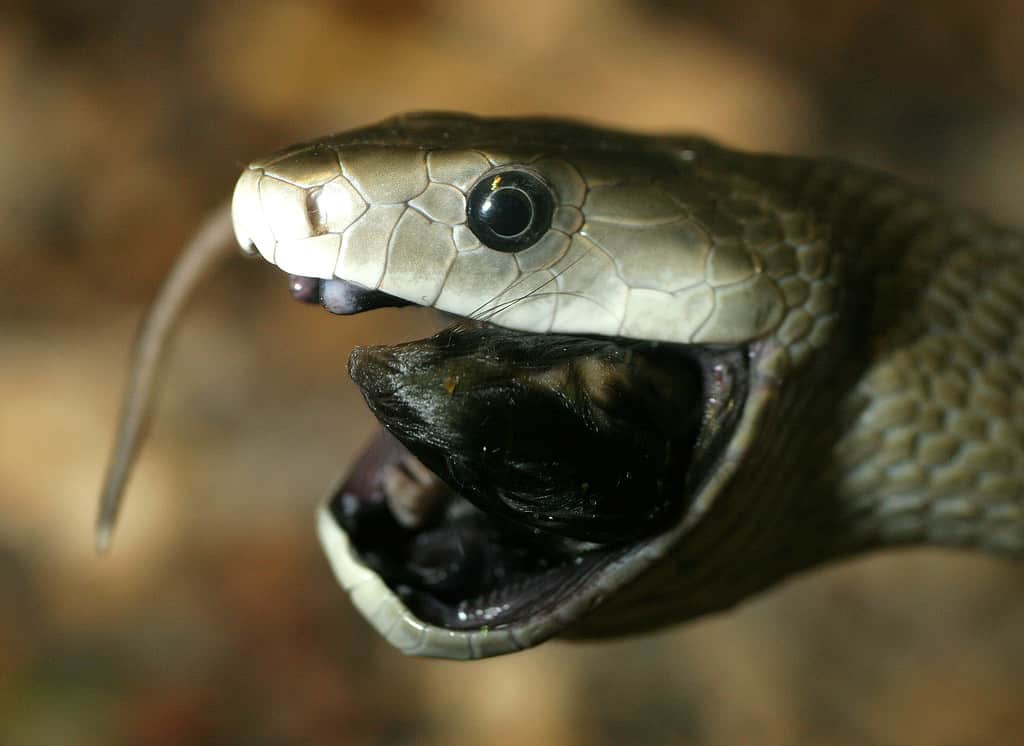Black mambas are well-known to be one of the fastest and most venomous snakes existing today. They are certainly the longest venomous snake native to Africa, the continent they reside in. These snakes are quick, resilient, and incredible to watch in action. But, just how fast can a black mamba go? In this article, we’ll discover the top speeds of this snake, alongside their attack methods and some of the most popular misconceptions regarding this species. You’ll come to find that these captivating creatures are just as fascinating as they are deadly!
Identifying a Black Mamba

Don’t let the name “black mamba” fool you- these snakes aren’t actually black at all!
©NickEvansKZN/Shutterstock.com
if you’re adventuring in a dry environment within sub-Saharan Africa, there is certainly a chance that you may stumble upon a black mamba in its natural habitat. And, with no documented species decline reported by the IUCN (Union for Conversation of Nature), this snake isn’t going anywhere anytime soon. But, how exactly can you tell these snakes apart from the rest? They certainly have quite a few identifying factors.
As we mentioned in our introduction, the black mamba is the longest venomous snack on the African continent. The average length of this snake is somewhere between seven and nine feet, but there have been instances where they’ve reached ten feet. Not only are they the longest in Africa, but they’re the second longest venomous snake in the entire world, with only the king cobra in front of them.
In terms of coloration, the name “black mamba” can be a bit misleading. In actuality, these snakes aren’t black at all. Well, except for the inside of their mouths, which is where their namesake originates from. In actuality, the color of a black mamba will usually be some combination of olive green, light brown, or grey.
How Fast Are Black Mambas?

Though the black mamba is fast enough to chase after a human, the truth is that it has little to no interest in following you around.
©Cormac Price/Shutterstock.com
It’s time to answer the question that’s on everyone’s mind- just how fast are these incredible snakes? Though this level of speed can only be maintained over short distances, the black mamba can travel up to 12.5 mph. This is incredibly impressive, as very few snakes can even crack the 10 mph mark at their fastest.
If you’re wondering whether or not a human could outrun one of these snakes, the answer is a resounding no. That’s because even at their lower, slower speed, the snake can travel up to 7 mph. Since humans have an average running speed of 6 mph, only someone with Olympic-level athletic prowess would have a chance to escape this serpent.
Black Mamba Myths and Misconceptions
As with any popular reptile, there are certainly going to be rumors circulated. But, with black mambas in particular, these rumors run rampant! There are several popularized misconceptions about these snakes, most likely stemming from their ferocious status as quick and efficient hunters. It’s important to clarify the facts from the falsehoods to garner a stronger understanding of the species.
The first, and most popular, myth about these snakes is that they actively seek out humans to harm them. This is one that is not only popular with the black mamba, but many other snakes as well. You see, this couldn’t be further from the truth. In actuality, black mambas will make every effort to avoid interactions with humans in general. These snakes have no qualms with humans, despite their ability to take one down if needed. This species of snake, as with most venomous snakes, will only attack if it feels truly cornered and threatened.
The second most popular myth is certainly an interesting one! Because of how fast black mambas are, people believe that these snakes will get into high-speed chases with their prey. Sure, maybe sometimes, but these rumors stretch even further. There is a semi-popular belief that when a black mamba rolls down a hill, it bites its own tail to form a circular loop. Upon reaching the hill’s bottom, it snaps back into its straight form and strikes. This is, we assure you, a complete myth. It would be pretty cool if they could do that, though!
The Black Mamba Attack Method

The fangs of a black mamba can reach up to 22mm in length.
©Tad Arensmeier, CC BY-SA 3.0 – License
Their incredible speed isn’t the only thing that makes the black mamba a formidable foe! Aside from being the fastest, these snakes are also some of the most venomous. Their venom delivery system is considered to be highly evolved, and in combination with their speed, this makes them quite a successful hunter.
The venom of a black mamba is primarily made from neurotoxins, that work to cut off the central nervous system of the prey in question. When this happens, death is ensured, but not before a painful bout of respiratory failure. If their striking speed and deadly venom aren’t enough, then their massive fangs will certainly do the trick. Reaching up to 22 mm in length, getting struck by these is nothing less than horrifying.
If a human were to have the unfortunate experience of getting bitten by a black mamba, they would have roughly twenty minutes to administer antivenin before ultimately succumbing to their fatal injury. There are actually two documented cases of this rapid-acting venom taking less than 20 minutes to do its work. Luckily, such an antivenin does exist. But, it is not available in many of the more rural areas that these snakes inhabit. Because of this, deaths from black mamba snake bites are still relatively common in those parts of the world.
The photo featured at the top of this post is © Tad Arensmeier, CC BY-SA 3.0 – License / Original
Discover the "Monster" Snake 5X Bigger than an Anaconda
Every day A-Z Animals sends out some of the most incredible facts in the world from our free newsletter. Want to discover the 10 most beautiful snakes in the world, a "snake island" where you're never more than 3 feet from danger, or a "monster" snake 5X larger than an anaconda? Then sign up right now and you'll start receiving our daily newsletter absolutely free.
Thank you for reading! Have some feedback for us? Contact the AZ Animals editorial team.






